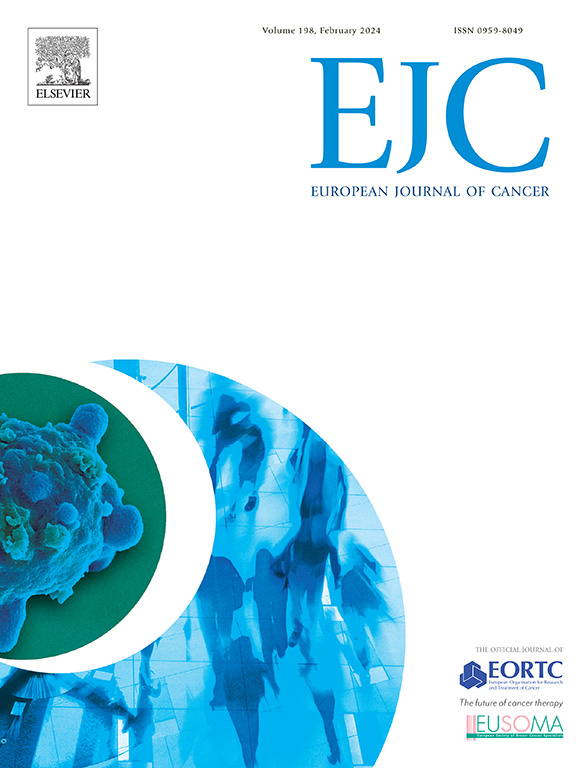一线与二线西米单抗治疗晚期基底细胞癌的实际经验
IF 7.6
1区 医学
Q1 ONCOLOGY
引用次数: 0
摘要
抗pd1抗体(PD1i) cemiplimab被批准作为局部晚期或转移性基底细胞癌(BCC)的二线治疗药物,ORR为20 - 30% %。本研究旨在调查在德国现实世界患者队列中,cemiplimab作为BCC一线或二线治疗的疗效。方法回顾性地从前瞻性多中心真实世界皮肤癌登记ADOREG中确定组织学证实的局部晚期或转移性BCC患者,这些患者接受了西米单抗治疗。研究终点是总缓解率(ORR)、无进展生存期(PFS)和总生存期(OS)。比较一线和二线接受西米单抗治疗的患者治疗结果。结果来自17个皮肤癌中心的37例患者接受了西米单抗治疗。任何一线治疗开始后的中位随访时间为37.1个月,任何头孢单抗治疗开始后的中位随访时间为17.9个月。接受一线西米单抗治疗的患者(n = 8)的ORR为62.5 %,而接受二线西米单抗治疗的患者(n = 29)的ORR为31.0 %;一线西米单抗的中位PFS为19.8个月,二线西米单抗为5.3个月。二线西米单抗治疗进展后再次诱导HHIs的ORR为20.0 %,中位PFS为3.8个月。结论:我们在之前的注册研究中证实,在真实世界的患者队列中,cemiplimab作为BCC的二线治疗具有可比的结果。此外,我们发现一线治疗的结果有更有利的趋势,这表明进一步研究cemiplimab作为晚期BCC一线治疗的理由。本文章由计算机程序翻译,如有差异,请以英文原文为准。
Real-world experience with first- versus second-line cemiplimab for advanced basal cell carcinoma
Background
The anti-PD1 antibody (PD1i) cemiplimab is approved as second-line treatment for locally advanced or metastatic basal cell carcinoma (BCC), resulting in an ORR of 20–30 %. This study aimed to investigate the efficacy of cemiplimab as first-line or second-line treatment of BCC in a German real-world patient cohort.
Methods
Patients with histologically confirmed locally advanced or metastatic BCC who were treated with cemiplimab were retrospectively identified from the prospective multicenter real-world skin cancer registry ADOREG. Study endpoints were overall response rate (ORR), progression-free survival (PFS), and overall survival (OS). Therapy outcome was compared between patients receiving first-line cemiplimab and patients treated with cemiplimab in second-line.
Results
37 patients from 17 skin cancer centers were identified who received cemiplimab. The median follow-up after start of any first-line treatment was 37.1 months, and 17.9 months after initiation of any cemiplimab treatment. Patients who received first-line cemiplimab (n = 8) had an ORR of 62.5 %, compared to an ORR of 31.0 % for patients who received second-line cemiplimab (n = 29); Median PFS was 19.8 months for first-line cemiplimab and 5.3 months for second-line cemiplimab. Reinduction with HHIs after progression on second-line cemiplimab resulted in an ORR of 20.0 % and a median PFS of 3.8 months.
Conclusion
We demonstrate a comparable outcome for cemiplimab as second-line treatment of BCC in our real-world patient cohort as reported in previous registration studies. Additionally, we found a trend for a more favorable outcome in first-line therapy, suggesting a rationale to further investigate cemiplimab as first-line treatment of advanced BCC.
求助全文
通过发布文献求助,成功后即可免费获取论文全文。
去求助
来源期刊

European Journal of Cancer
医学-肿瘤学
CiteScore
11.50
自引率
4.80%
发文量
953
审稿时长
23 days
期刊介绍:
The European Journal of Cancer (EJC) serves as a comprehensive platform integrating preclinical, digital, translational, and clinical research across the spectrum of cancer. From epidemiology, carcinogenesis, and biology to groundbreaking innovations in cancer treatment and patient care, the journal covers a wide array of topics. We publish original research, reviews, previews, editorial comments, and correspondence, fostering dialogue and advancement in the fight against cancer. Join us in our mission to drive progress and improve outcomes in cancer research and patient care.
 求助内容:
求助内容: 应助结果提醒方式:
应助结果提醒方式:


